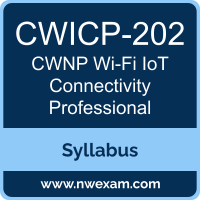 A great way to start the CWNP Certified Wireless IoT Connectivity Professional (CWICP) preparation is to begin by properly appreciating the role that syllabus and study guide play in the CWNP CWICP-202 certification exam. This study guide is an instrument to get you on the same page with CWNP and understand the nature of the CWNP Wi-Fi IoT Connectivity Professional exam.
A great way to start the CWNP Certified Wireless IoT Connectivity Professional (CWICP) preparation is to begin by properly appreciating the role that syllabus and study guide play in the CWNP CWICP-202 certification exam. This study guide is an instrument to get you on the same page with CWNP and understand the nature of the CWNP Wi-Fi IoT Connectivity Professional exam.
Our team of experts has composed this CWNP CWICP-202 exam preparation guide to provide the overview about CWNP Wireless IoT Connectivity Professional exam, study material, sample questions, practice exam and ways to interpret the exam objectives to help you assess your readiness for the CWNP CWICP exam by identifying prerequisite areas of knowledge. We recommend you to refer the simulation questions and practice test listed in this guide to determine what type of questions will be asked and the level of difficulty that could be tested in the CWNP Wi-Fi IoT Connectivity Professional certification exam.
CWNP CWICP-202 Exam Overview:
|
Exam Name
|
Wireless IoT Connectivity Professional |
| Exam Number | CWICP-202 CWICP |
| Exam Price | $350 USD |
| Duration | 90 minutes |
| Number of Questions | 60 |
| Passing Score | 70% |
| Exam Registration | Prometric |
| Sample Questions | CWNP CWICP-202 Sample Questions |
| Practice Exam | CWNP Certified Wireless IoT Connectivity Professional Practice Test |
CWNP CWICP-202 Exam Topics:
| Section | Weight | Objectives |
|---|---|---|
| Wireless IoT Technologies and Solutions | 10% |
- Understand wireless IoT architectures
- Identify the benefits and constraints of various wireless IoT architectures and technologies
- Understand and apply knowledge of the benefits and constraints/limitations of discrete IoTrelated features for the purpose of making recommendations of technologies that will meet a requirement, such as battery life/time, distance, etc. - Understand wireless IoT components
- Differentiate between component interactions and architectures of specific wireless IoT technologies
|
| Wireless IoT RF Characteristics |
10%
|
- Understand frequency band characteristics
- Understand the characteristics of commonly used IoT frequency bands including 400MHz, 800/900MHz, 2.4GHz - Concepts and relationships of frequencies to FSPL - Effect of receive sensitivity on RSSI across various bands (Friis Transmission Equation) - Incumbents in the airspace - Propagation characteristics - Explain channel widths, SINR, SNR and power considerations - Understand the characteristics of commonly used IoT RF bands - Relationship of channel widths to SNR (SNR as a function of channel width) - Rx/Tx power considerations, - Causes and effects of dynamic range compression and desense |
| Wireless IoT PHY Structure and Operations | 20% |
- Understand 802.15.4 PHY structure and operations used in IoT
- Understand LoRa PHY structure and operations
- Understand Z-Wave PHY structure
- Understand Bluetooth Low Energy (BLE) PHY structure and operations used in IoT
- Demonstrate knowledge of essential characteristics and applications of these PHYs:
|
| Wireless IoT MAC Layer Structure and Operations | 20% |
- Understand 802.15.4 MAC layer structure and operations for IoT
- Understand LoRaWAN MAC layer structure and operations for IoT
- Understand Bluetooth Low Energy (BLE) MAC layer structure and operations for IoT
|
| Wireless IoT Upper Layers Protocols | 20% |
- Understand Zigbee upper layer protocols network topology including:
- Understand 6LoWPAN upper layer protocols
- Understand Thread upper layer protocols
- Understand WirelessHART and ISA100.11a upper layer protocols
- Understand ISA100.11a Data Link and Network layer interactions and operations, including:
- Describe the Matter layered architecture
|
| Wireless IoT Security | 10% |
- Understand and apply IoT privacy and integrity concepts
- Understand and apply secure provisioning & access control in IoT
- Implement IoT technology against a defined security policy
- Implement network protection as required including:
- Understand the different security requirements of data-centric vs. action-centric IoT solutions
- Describe best practices for IoT network security and monitoring
|
| Validate and Troubleshoot Wireless IoT Solutions | 10% |
- Identify and solve common IoT issues and/or misconfiguration
- Demonstrate applied knowledge of IoT-concepts for troubleshooting and configuration changes when required
- Validate against a defined set of requirements
- Validate against recommended best practices
|
CWNP CWICP Exam Description:
The Certified Wireless IoT Connectivity Professional (CWICP) understands IoT connectivity standards and operation in business and industrial networks. This knowledge can be applied to deploy and troubleshoot the most common wireless IoT protocols with an in-depth understanding of their operations. A CWICP should be able to identify the technology and security requirements for a given IoT solution.
